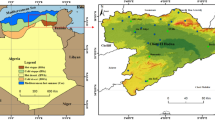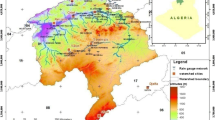Abstract
Probable maximum precipitation (PMP) and probable maximum flood (PMF) methods help to define extreme rainfall and discharge magnitudes for dam and reservoir planning and design aims. In this paper, probabilistic and statistical calculation approaches are presented for physically meaningful PMP amounts from 12 meteorology station annual daily maximum rainfall values in and around the Jeddah City, Kingdom of Saudi Arabia. The climate change impact is considered as 15% for future projections. The results show that the values range between 62.1 and 244.0 mm, but the climate change impact calculations vary between 71.4 and 280.6 mm. These values are used to generate regional PMP contour maps for PMF calculations, and hence, possible flood danger on Jeddah City is assessed with the support of meaningful graphs and maps. Finally, in order to appreciate how close are the calculated PMP values to the recorded maximum daily rainfall amounts, an efficiency factor is defined as the ratio of the maximum daily rainfall to the calculated past and climate effective PMPs. The frequency factor is found to vary between 2.7 and 6.6, which are rather low compared to humid parts of the world, but in good agreement in many arid and semiarid region values.



















Similar content being viewed by others
References
Al Sarmi S, Washington R (2013) Changes in climate extremes in the Arabian Peninsula: analysis of daily data. Int J Climatol. doi:10.1002/joc.3772
Al Saud M (2010) Assessment of Flood Hazard of Jeddah Area 2009, Saudi Arabia. J Water Resour Prot 2:839–847
Almazroui M (2013) Simulation of present and future climate of Saudi Arabia using a regional climate model (PRECIS). Int J Clim 33:2247–2259
Barros AP, Lettenmaier DP (1994) Dynamic modeling of orographically-induced precipitation. Rev Geophys 32:265–284
BOM (Bureau of Meteorology) (1994) The estimation of PMP in Australia: generalized short-duration method (GSDM). Australian Government, Bulletin 53, Canberra
Casas MC, Rodríguez R, Prohom M, Gázquez A, Redaño A (2011) Estimation of the probabilistic maximum precipitation in Barcelona (Spain). Int J Clkimatol 31:1322–1327
Collier CG, Hardaker PJ (1996) Estimating probable maximum precipitation using a storm model approach. J Hydrol 183:277–306
Corrigan P, Fenn DD, Kluck DR, Vogel JL (1999) Probable maximum precipitation for California. Hydrometeorological Report No. 59. Silver Spring
De Vries AJ, Tyrlis E, Edry D, Krichak SO, Steil B, Lelieveld J (2013) Extreme precipitation events in the Middle East: dynamics of the Active Red Sea Trough. J Geophys Res Atmos 118:7087–7108
Desa M, Noriah AB, Rakhecha PR (2001) Probable maximum precipitation for 24-hr duration over Southeast Asian monsoon region—Selangor, Malaysia. Atmos Res 58(1):41–54. doi:10.1016/S0169-8095(01)00070-9
Ellen MD, Ana PB (2003) Probable maximum precipitation estimation using multifractals: application in the Eastern United States. Am Meteorol Soc J Hydromet 4:1012–1024
Fattahi E, Noorian AM, Noohi K (2010) Comparison of physical and statistical methods for estimating probable maximum precipitation in southwestern basins of Iran. DESERT 15:127–132
Foufoula-Georgiou E (1989) A probabilistic storm transposition approach for estimating exceedence probabilities of extreme precipitation depths. Water Resour Res 25:799–815
Ghahraman B (2008) The estimation of one day duration probable maximum precipitation over Atrak watershed in Iran. Iran J Sci Technol Trans B Eng 32:175–179
Graham WJ (2000) Should dams be modified for the probable maximum flood? J Am Water Resour Assoc 36:953–963
Hansen EM, Schreiner LC, Miller JF (1982) Application of probable maximum precipitation estimates, United States east of the 105th meridian. Hydro-meteorological report 52. National Weather Service, Silver Spring
Hershfield DM (1961) Estimating the probable maximum precipitation. J Hydraul Div Am Soc Civ Eng 87:99–106
Hershfield DM (1965) Method for estimating probable maximum precipitation. J Am Water Works Assoc 57:965–972
Koutsoyiannis D (1999) A probabilistic view of Hershfield’s method for estimating probable maximum precipitation. Water Resour Res 35:1313–1322
National Research Council (NRC) (1994) Estimating bounds on extreme precipitation events. National Academy Press, Washington, DC
Papalexiou SM, Koutsoyiannis D (2006) A probabilistic approach to the concept of probable maximum precipitation. Adv Geosci EGU 7:51–54
Rakhecha PR, Clark C (2002) Areal PMP distribution of one day to three-day duration over India. Meteorol Appl 9:399–406. doi:10.1017/S1350482702004024
Şen Z (2005) The Saudi Geological Survey hydrograph method for use in arid regions. Technical Report, SGS-TR-2004-5. SGS, Jeddah
Şen Z (2008) Wadi hydrology. CRC Publishers, Taylor and Francis Group, Baco Raton, p 385
Şen Z, Al Alsheikh AA, Al-Dakheel AM, Alamoud AI, Alhamid AA, El-Sebaay AS (2011) Climate change and Water Harvesting possibilities in arid regions. Int J Global Warm 3(4):355–361
Sherif M, Almulla M, Shetty A, Chowdary RK (2013) Analysis of rainfall, PMP and drought in the United Arab Emirates. Int J Climatol. doi:10.1002/joc.3768
Snyder FF (1938) Synthetic unit hydrographs. Trans AGU 19:447–454
Subyani MA (2011) Hydrologic behavior and flood probability for selected arid basins in Makkah area, western Saudi Arabia. Arab J Geosci 4:817–824
Svensson C, Rakhecha PR (1998) Estimation of probable maximum precipitation for dams in the Hongru River catchment, China. Theor Appl Clim 59:79–91
Wang BHM (1984) Estimation of probable maximum precipitation: case studies. J Hydraul Eng 110:1457–1472
WMO (World Meteorological Organization) (1986) Manual for estimation of probable maximum precipitation. Operational hydrology, Report1. WMO-No. 332, p 269
WMO (World Meteorological Organization) (2009) Manual for estimation of probable maximum precipitation. WMO No. 1045, Geneva
Zhang X, Aguilar E, Sensoy S, Melkonyan H, Tagiyeva U, Ahmed N et al (2005) Trends in Middle East climate extreme indices from 1950 to 2003. J Geophys Res Atmos. doi:10.1029/2005JD006181
Author information
Authors and Affiliations
Corresponding authors
Additional information
This article is a part of a Topical Collection, “Environmental Geology in Saudi Arabia”; edited by Zhou Wanfang and Olaf Kolditz.
Rights and permissions
About this article
Cite this article
Şen, Z., As-Sefry, S. & Al-Harithy, S. Probable maximum precipitation and flood calculations for Jeddah area, Kingdom of Saudi Arabia. Environ Earth Sci 76, 5 (2017). https://doi.org/10.1007/s12665-016-6312-z
Received:
Accepted:
Published:
DOI: https://doi.org/10.1007/s12665-016-6312-z




